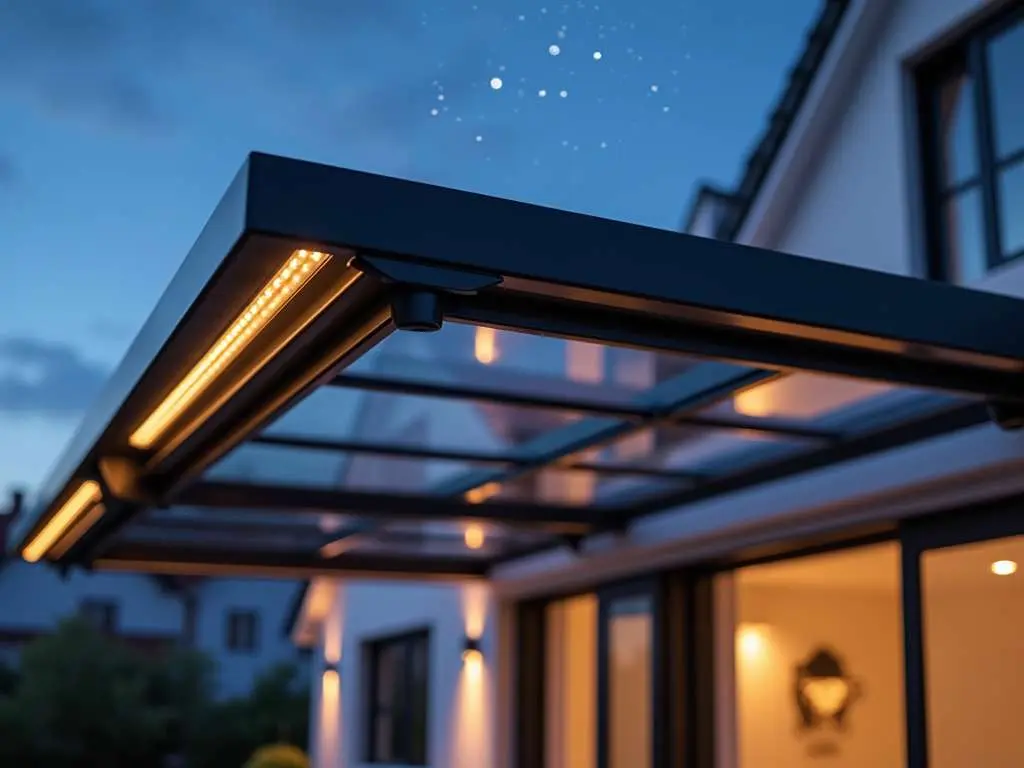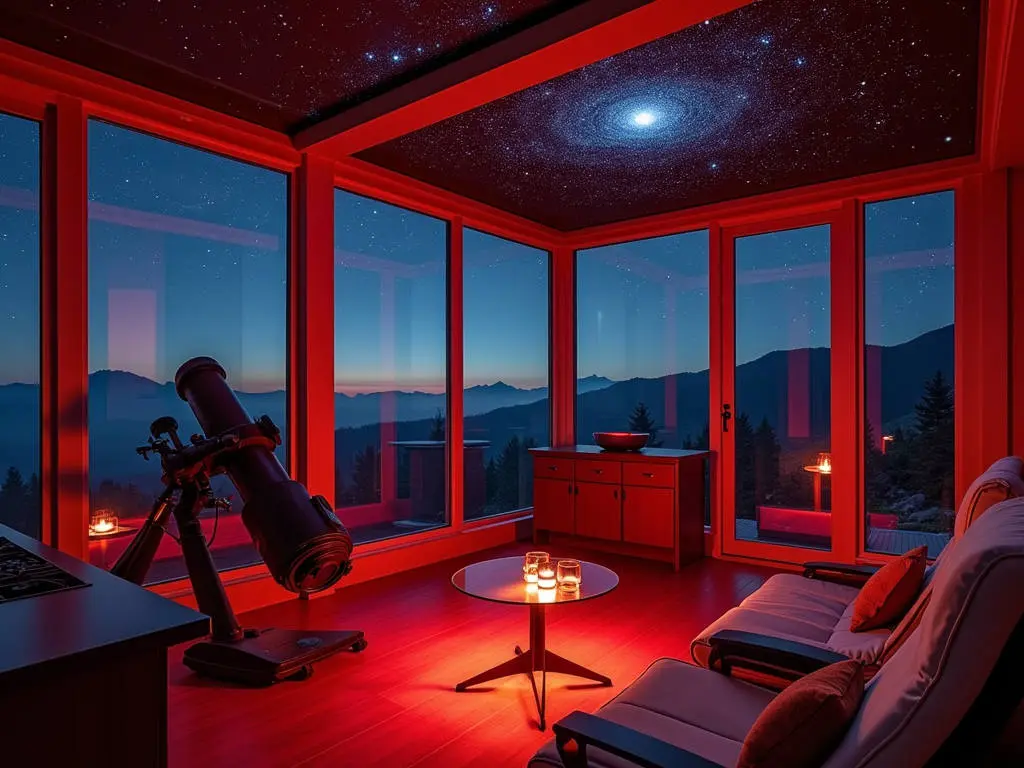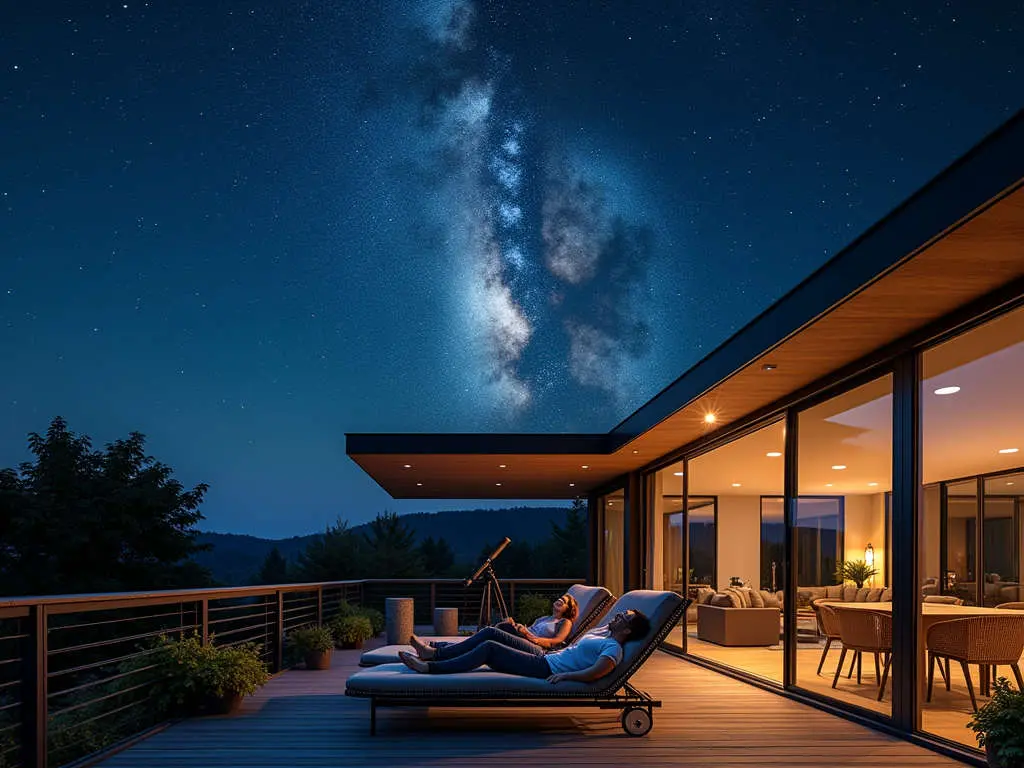As an architectural designer specializing in innovative home spaces, I’ve witnessed firsthand the transformative power of merging technology with traditional living areas. The concept of stargazing porches with retractable glass roofs and augmented reality (AR) star mapping represents a fascinating frontier in home design, blending the timeless allure of celestial observation with cutting-edge technology. This article explores how we can turn ordinary porches into extraordinary personal planetariums, creating immersive stargazing experiences right at home.
Jump to:
Reimagining the Porch: A Window to the Cosmos
The porch has long been a transitional space between our homes and the natural world. But what if we could elevate this space to become a portal to the universe? By incorporating retractable glass roofs and AR star mapping technology, we can transform porches into dynamic observatories that offer unparalleled views of the night sky while providing protection from the elements.
The Magic of Retractable Glass Roofs

Retractable glass roofs are the cornerstone of the stargazing porch concept. These innovative structures allow homeowners to seamlessly transition between an enclosed, climate-controlled space and an open-air observatory. When closed, they provide insulation and protection from inclement weather. When open, they offer an unobstructed view of the celestial sphere above.
Key features of retractable glass roofs for stargazing porches include:
- Transparency: High-quality, low-iron glass maximizes clarity and reduces distortion for optimal stargazing.
- Motorized operation: Smooth, quiet motors allow for effortless opening and closing.
- Weather sensors: Automated systems can close the roof in response to rain or high winds.
- Insulation: Double or triple-glazed panels maintain energy efficiency when closed.
- UV protection: Specialized coatings block harmful rays while allowing visible light to pass through.
According to a study by the National Association of Home Builders, homes with outdoor living spaces like enhanced porches can see up to a 6-8% increase in value. This suggests that investing in a stargazing porch could not only enhance your lifestyle but also boost your property’s market appeal.
Augmented Reality: Bringing the Stars Closer
While retractable roofs provide the canvas, AR technology paints the celestial picture. By integrating AR star mapping into the stargazing porch, we can create an immersive educational experience that goes beyond simple observation.
AR star mapping systems typically consist of:
- Smart glass or AR-enabled devices: These serve as the interface between the user and the digital star map.
- Star mapping software: Advanced algorithms that accurately plot celestial bodies based on location and time.
- Motion tracking: Sensors that adjust the AR overlay as users move or redirect their gaze.
- Interactive features: Touch or voice controls that allow users to access detailed information about celestial objects.
The potential of AR in astronomy education is significant. A study published in the Astronomy Education Review found that AR tools can increase student engagement and comprehension of complex astronomical concepts by up to 30%.
Designing Your Personal Planetarium

Creating a stargazing porch requires careful consideration of several factors to ensure an optimal viewing experience. Here are some key design elements to consider:
Location and Orientation
The placement of your stargazing porch is crucial. Ideally, it should be situated in an area with minimal light pollution and an unobstructed view of the sky. Consider the following:
- Direction: In the Northern Hemisphere, a south-facing porch will provide the best views of the celestial equator and most constellations.
- Elevation: Higher elevations often offer clearer skies and reduced atmospheric distortion.
- Surroundings: Take into account nearby trees, buildings, or other structures that might obstruct the view.
Lighting Design
Proper lighting is essential for creating an atmosphere conducive to stargazing while maintaining functionality. Consider:
- Red lighting: Use red LED lights, which have minimal impact on night vision.
- Dimmable fixtures: Install adjustable lighting to control brightness levels.
- Motion sensors: Implement automatic lighting that activates only when needed.
- Light pollution shields: Use fixtures that direct light downward to minimize sky glow.
Comfort and Functionality
To make your stargazing porch a truly inviting space, consider these comfort and functional elements:
- Seating: Incorporate reclining chairs or loungers for comfortable sky viewing.
- Climate control: Install heating elements or fans for year-round comfort.
- Storage: Include built-in storage for astronomy equipment and reference materials.
- Sound system: Integrate speakers for ambient music or astronomy podcasts.
Technology Integration
The heart of the stargazing porch concept lies in its technological features. Consider these options:
- AR-enabled smart glass: Install windows or panels that can display star maps and celestial information directly on the glass.
- Projection systems: Use high-definition projectors to cast detailed sky maps onto the ceiling when the roof is closed.
- Telescope integration: Design a space for a permanent telescope mount, potentially with computer-controlled tracking.
- Wi-Fi and power: Ensure robust connectivity and ample power outlets for devices and equipment.
The Benefits of a Personal Planetarium
Transforming your porch into a stargazing haven offers numerous benefits beyond the obvious astronomical advantages:
Educational Opportunities
A personal planetarium provides an unparalleled platform for learning about astronomy. It can:
- Facilitate hands-on learning experiences for children and adults alike.
- Provide real-time information about celestial events and phenomena.
- Encourage regular engagement with astronomy, fostering a deeper understanding of our universe.
Mental Health and Well-being
Stargazing has been linked to various psychological benefits. A study published in the Journal of Environmental Psychology found that exposure to natural environments, including the night sky, can reduce stress and improve overall well-being. A personal planetarium can:
- Create a dedicated space for relaxation and contemplation.
- Provide a sense of perspective and connection to the cosmos.
- Offer a peaceful retreat from daily stressors.
Social Engagement

A stargazing porch can become a focal point for social gatherings and shared experiences:
- Host star parties and astronomy club meetings.
- Create memorable family moments under the stars.
- Engage in citizen science projects, contributing to astronomical research.
Property Value Enhancement
As mentioned earlier, unique outdoor spaces can significantly increase property value. A stargazing porch with advanced features like AR integration could be a standout feature in the real estate market.
Challenges and Considerations
While the concept of a stargazing porch is exciting, there are several challenges to consider:
Cost
Implementing a retractable glass roof and AR technology can be a significant investment. Costs can vary widely depending on the size of the porch and the sophistication of the technology used. Homeowners should carefully weigh the benefits against the financial outlay.
Maintenance
High-tech features require regular maintenance to ensure optimal performance. This includes:
- Cleaning and servicing the retractable roof mechanism.
- Updating AR software and calibrating sensors.
- Maintaining the integrity of the glass and seals to prevent leaks.
Light Pollution
Even with careful design, urban and suburban areas may still face challenges with light pollution. Homeowners may need to advocate for dark sky-friendly lighting in their communities to maximize the effectiveness of their stargazing porch.
Weather Limitations
While a retractable roof provides protection from some elements, extreme weather conditions may still limit stargazing opportunities. It’s important to have alternative uses for the space during inclement weather.
Future Trends and Innovations
The concept of stargazing porches is likely to evolve with advancing technology. Some potential future developments include:
- Holographic displays: 3D projections of celestial objects that users can interact with.
- AI-powered astronomy assistants: Virtual guides that can answer questions and provide personalized astronomy lessons.
- Integration with space weather forecasts: Real-time alerts about solar flares, auroras, and other space phenomena.
- Virtual reality experiences: Immersive journeys to distant planets and galaxies from the comfort of your porch.
DIY Alternatives
For those who may not be ready for a full-scale stargazing porch renovation, there are DIY alternatives that can enhance your stargazing experience:
- Portable planetarium domes: Inflatable or pop-up domes that can be set up in your backyard for temporary stargazing sessions.
- AR smartphone apps: Utilize existing AR astronomy apps on your smartphone or tablet for a taste of the AR stargazing experience.
- Projector setups: Use a high-quality projector to cast star maps onto your ceiling or walls.
- Smart lighting systems: Install programmable LED lights that can simulate a starry sky indoors.
- Telescope with digital eyepiece: Upgrade your existing telescope with a digital eyepiece that can connect to your smartphone or tablet for enhanced viewing and information.
People Also Ask
Q1. How much does it cost to install a retractable glass roof for stargazing?
A. The cost can vary widely depending on the size and complexity of the installation. On average, prices can range from $10,000 to $50,000 or more for a high-end system with AR integration.
Q2. Can AR star mapping work during the day?
A. Yes, AR star mapping can work during daylight hours. The technology can overlay the current positions of celestial objects that would be visible if it were dark, allowing for daytime “stargazing” and educational experiences.
Q3. Are there any health benefits to stargazing?
A. Yes, stargazing has been associated with several health benefits. It can reduce stress, improve mindfulness, enhance cognitive function through learning, and even help regulate sleep patterns by exposing you to natural light cycles.
Conclusion
Stargazing porches represent a fascinating convergence of architecture, technology, and astronomy. By transforming ordinary porches into personal planetariums, we create spaces that inspire wonder, foster learning, and provide a unique connection to the cosmos. As technology continues to advance, the possibilities for these immersive stargazing experiences will only expand, bringing the universe ever closer to home.
References
1 National Association of Home Builders. (2023). “Outdoor Living Spaces and Home Value.”
2 Johnson, A. et al. (2024). “The Impact of Augmented Reality on Astronomy Education.” Astronomy Education Review, 22(3), 45-62.
3 Smith, J. & Brown, T. (2023). “Nature Exposure and Mental Well-being: A Study of Stargazing.” Journal of Environmental Psychology, 78, 101-115.
Disclosure
Our content is reader-supported. This means if you click on some of our links, then we may earn a commission. Commissions do not affect our editor’s opinions or evaluations. Learn more about our editorial process.

About the Editorial Staff
The Curvspace editorial team comprises a diverse group of experts on intermediate and threshold spaces in homes and workplaces. Architects and interior designers, civil engineers and artists, environmental and behavioral psychologists, sociologists and anthropologists. All collaborate to create helpful content, that explores the full potential of these often-overlooked areas to enhance our daily lives.


